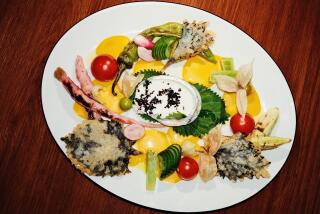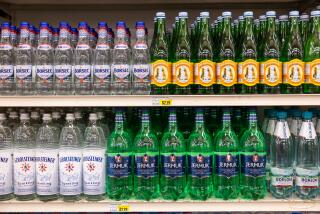In Hawaii, awa makes a comeback
SPECIAL ISSUE | WILD HAWAII Awa, a native elixir associated with friendship, makes a comeback.
By Julia Steele
Special to the Los Angeles Times
Honolulu
At first glance, the Diamond Head Cove Health Bar hardly looks like it’s in the vanguard of 21st century Hawaiian culture. True, it sits on the slopes of the islands’ most famous landmark, Diamond Head. But it’s in a mini-mall, sandwiched between a beauty parlor and a barbecue plate lunch shop. There’s neon in the windows and a Mexican restaurant across the street.
Step inside, however, and you’ll know in an instant that you’ve left Waikiki behind and tapped into the native zeitgeist. In one corner, a group of young people is speaking fluent Hawaiian. In another, noted musician Jeff Peterson is playing slack-key guitar. Bunches of ripening bananas hang from the ceiling. Surf photographs and paintings cover the walls.
“The spirit of my shop goes like this,” says Marcus Marcos, the Cove’s owner. “Where would you want to go to experience local food, culture, artists, musicians, farmers, fishermen? It’s here. It’s local everything, man.”
Local everything, including the just-caught ahi and the fresh coconuts. But what transformed the Cove from just another smoothie bar into a Hawaiian gathering place is the most popular drink on the menu, awa.
Awa, or kava as it’s also known, is Oceania’s elixir, imbibed for countless centuries throughout the Pacific and infused with major social import. In Fiji and Samoa, awa remains second only to water; in Hawaii, awa drinking fell off after the missionaries arrived and it became almost impossible to find — until recently.
At the Cove, one of two awa bars here, you can walk in and for $5 get a coconut shell full of the stuff. On the heels of a native cultural renaissance and a political sovereignty movement, heading to the awa house has become another way to live like a Hawaiian.
“The awa bar is a haven, a place to kukakuka, talk story, discuss the day’s events,” says regular Andre Perez. He is just back from a week in Mississippi leading classes and workshops for about 900 Hawaiians incarcerated there. Perez is part of Hale Mua, or men’s house, a Hawaiian cultural and spiritual group.
“Our goal is to raise the consciousness of our people to live a pono, or balanced, lifestyle,” he says. “We don’t have a hale [house] yet — the Hawaiians have been so disenfranchised — but Marcos’ place serves as a temporary hale until we can find a permanent home.”
At a table outside sits Kaiao Aea, a University of Hawaii English major who comes weekly to drink awa and write. “Awa makes you a little more creative. It lets your brain do certain things you wouldn’t be able to do if you were stressing out,” he says. He pulls out a journal, flips through poetry he has composed after drinking awa and hands over one titled “Aloha” that begins this way:
Let your fingers be
The roots with which you
Grasp this land and receive a sustenance
Unseen by the eye but felt
By the spirit and sung aloud.
Awa is made from the root of the Piper methysticum plant, which is harvested, ground, pounded, mixed with water and strained. The resulting drink is full of kavalactones, which basically slow the body down; it’s the opposite effect of a caffeine high. (Like coffee, awa is not regulated.) Drink it and you may achieve the experience your Hawaiian vacation promised, relaxation.
“It’s like the feeling you get right after a massage,” says John Langan, who’s in the Cove trying awa for the first time. “It makes you relaxed, a little sleepy.”
At the next table, Honolulu musicians Seann Carroll and Mike White are on their second round of the night. Why drink awa? Carroll stares into his bowl pensively. “Not for the taste, that’s for sure,” he says. Newcomers rarely relish awa’s flavor: It’s not uncommon to hear them liken it to soapy dishwater. And awa’s color — which can politely be described as beige to nut brown — makes it look like something out of a mud puddle.
Still, as White points out, “After a few sips, your mouth is numb, and you can’t taste it anymore anyway.” And with most drinkers, any initial distaste vanishes quickly. Serious awa drinkers sit around and discuss the drink’s differing varieties with the intensity of wine or beer aficionados.
Discussion, debate, kukakuka ... a lot of it goes on at the Cove. Marcos says awa promotes cognizance and conversation; certainly in the Pacific, the drink has been associated with camaraderie and communalism. The whole idea is to gather around a bowl, and regulars will tell you they come to the Cove to do just that.
“It’s the atmosphere,” says David Van Acker, “an eclectic coziness permeated with something local and intertwined in a very welcoming way.”
In the back of the store, Marcos’ friend Michael Puleloa is mixing up a fresh batch of moi, one of the most celebrated types of awa, once reserved for the supreme alii, or chief. When he’s done, Puleloa pours a bowl for Marcos and one for himself and the two sit down. Puleloa launches into a long discussion of awa through Hawaiian mythology and history.
“Awa was pretty much reserved for royalty,” he says at one point, “and to drink it is a privilege.” Marcos hears him say this, smiles, lifts his coconut shell to his lips and takes a deep draft. He cuts up some Hayden mango to go with the moi.
He gets up to make sure a neighboring table has what it needs. He moves through the Cove, inviting everyone to share in the privilege of discovering more about Hawaii’s past — and its future.
More to Read
Sign up for The Wild
We’ll help you find the best places to hike, bike and run, as well as the perfect silent spots for meditation and yoga.
You may occasionally receive promotional content from the Los Angeles Times.






